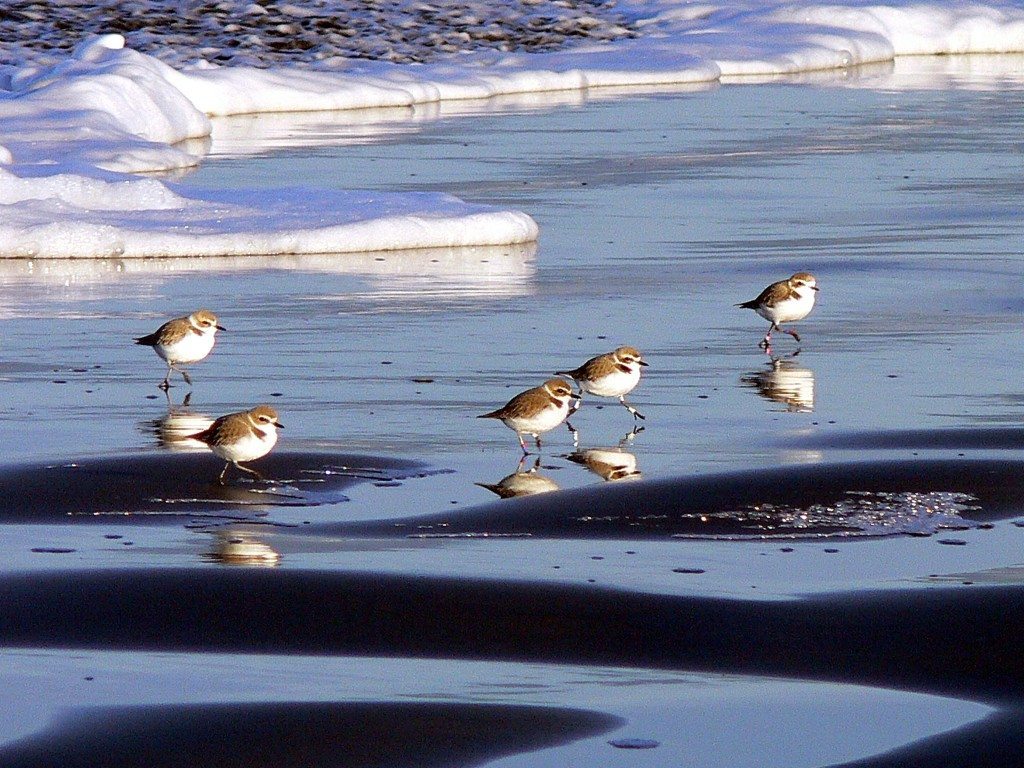Record number of Snowy Plovers on Ocean Beach
Editor’s Note: The San Francisco Chronicle ran an excellent story this weekend on San Francisco’s Snowy Plovers, which we are reprinting here in case you missed it. Our only quibble is with their description of longtime GGBA stalwart Dan Murphy as a… “hobby birder!” That’s kind of like describing Stephen Curry as an “adequate basketball player.” (Wink.) Click here to view the original story with the Chronicle’s plover photos.
By Lizzie Johnson
Tucked among the dunes of Ocean Beach, dozens of white-breasted shorebirds roost. And this year, their numbers have quadrupled.
The sandy shores of the Crissy Field Wildlife Protection Area and Ocean Beach are a stopping-point for the Western snowy plover, a 6-inch shorebird with dark patches on its back. The average count at the bird’s overwintering ground is usually in the mid-20s. But this January, National Park Service workers counted as many as 104 plovers in a single day.
That’s a record number since the Park Service began observing and monitoring the population in 1994, a year after the U.S. Fish and Wildlife Service designated the species as threatened. The snowy plover population on the West Coast — with 85 percent in California, and some in Oregon and Washington — has dwindled to 2,100 individuals, and they remain threatened by habitat loss, predation and human population growth.

Local number grows
“It’s really exciting that we have so many of these birds out there at the western edge of San Francisco,” said Bill Merkle, wildlife ecologist for the Golden Gate National Recreation Area. “The last couple of years, the local population has been increasing, especially this year. It is likely because the birds had good breeding years.”
But local numbers aren’t indicative of an overall snowy plover growth trend. The population has remained steady, largely because of habitat protection and education, said Andrea Jones, director of bird conservation for Audubon California.
“The population hasn’t been increasing or decreasing as a general trend,” Jones said. “That is both good and bad. There is a ton that goes into protecting these birds in their nesting habitats. At the same time, the population isn’t getting to where it needs to be.”
It has been tough for the species to recover because the snowy plover breeds and overwinters in different places, said Cindy Margulis, executive director of the Golden Gate Bird Alliance. The birds breed in coastal dune habitats in areas like Monterey and the Point Reyes National Seashore, and then rest in San Francisco during July through April.

Hunker down in sand
“You have to be concerned about the birds’ safety at their breeding sites and at their wintering sites, too,” she said. “It’s amazing to be able to see a whole flock of a threatened species, nearly 6 percent of the entire population of this species, in one area on the edge of a major city. But it’s a reminder of how precarious their existence is.”
The shorebird’s lifestyle is dependent on the tide cycle — they feed only at certain hours, and then hunker into the sand for warmth and to save energy. To the untrained eye, their cryptic coloration and stillness makes them almost invisible. But Dan Murphy, a hobby birder who has been following the species for nearly 30 years, can always find a few at Ocean Beach.
“Most of our birds come from around Monterey, though we do get a few from Oregon or farther south, like Santa Barbara,” he said. “They had a really good reproductive year which far exceeded previous years. This is really unusual, and it’s very exciting.”
Murphy said he spotted around 50 snowy plovers on Ocean Beach at the end of February — a sign of a successful nesting season.
“These birds are truly plagued by people,” he said. “They are hard to see, and people will walk right through the middle of them, making them waste valuable metabolic energy. Other people sic their dogs on the plover flock. They just don’t know and really threaten them.”
Environmental factors, like erosion, nonnative plant invasion and El Niño, have also put stress on the population, Merkle said. The plovers prefer wider, flatter sections of beach, which are becoming harder to find.
“A lot of these sites are challenged by, historically, development,” he said. “There’s invasion by European beach grass, which makes the dunes much denser. Increased raven populations prey upon the nests. As people, dogs and vehicles come through their habitat, they are burning energy instead of spending time resting and foraging. The plovers are just trying to rest and put on fat to build up their energy reserves.”
And, while the increase in shorebirds this year is a good sign, beachgoers should still stay far away from the birds, Margulis said. It could help the population remain healthy, allowing it to increase in numbers.
‘Give them a wide berth’
“If you detect the presence of snowy plovers, the most respectful thing is to give them a wide berth so they don’t have to waste any of their energy to get away from you,” Margulis said. “We know that in places where wintering flocks are being protected, such as Crown Beach in Alameda, they have a much easier time. Our urban area of around 8 million people means there’s a lot of pressure on our wildlife from all directions.”
———————————–
Learn more about efforts to protect Snowy Plovers on our web site. Come volunteer with us on the second Monday morning of each month, when we clean up debris at Crissy Field beach to make the beach habitat more welcoming for plovers and other wildlife. Details on the Volunteer page of our web site.
